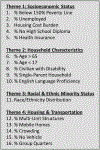The Effect of Social Vulnerability on Initial Stage and Treatment for Non-Small Cell Lung Cancer
- PMID: 38176296
- PMCID: PMC10872251
- DOI: 10.1016/j.lungcan.2023.107452
The Effect of Social Vulnerability on Initial Stage and Treatment for Non-Small Cell Lung Cancer
Abstract
Objective: The Social Vulnerability Index (SVI) is a composite metric for social determinants of health. The objective of this study was to determine if SVI influences stage at presentation for non-small cell lung cancer (NSCLC) patients and subsequent therapies.
Materials and methods: NSCLC patients from our local contribution to the National Cancer Database (2011-2021) were grouped into low SVI (<75 %ile) and high SVI (>75 %ile) cohorts. Demographics, cancer-related variables, and treatment modalities were compared. Multivariable logistic regression was performed to control for the impact of demographics on cancer presentation and for the impact of oncologic variables on treatment outcomes.
Results: Of 1,662 NSCLC patients, 435 (26 %) were defined as high SVI. Compared to the 1,227 (74 %) low SVI patients, highly vulnerable patients were more likely to be male (53.3 % vs 46.0 %, p = 0.009), non-White (17.2 % vs 9.7 %, p < 0.0001), have comorbidities (29.4 % vs 23.1 %, p = 0.009) and present at a higher AJCC clinical T, M and overall stage (all p < 0.05). These findings persisted on multivariable analysis, with highly vulnerable patients having 1.5x the odds (95 %CI: 1.23-1.86, p < 0.001) of presenting at more advanced stage. Patients with high SVI were less likely to be recommended for and receive surgery (40.9 % vs 53.2 %, p < 0.001), and this finding persisted after controlling for stage at presentation (OR 1.37, 95 %CI 1.04-1.80).
Conclusions: Highly vulnerable patients present at a more advanced clinical stage and are less likely to be recommended and receive surgery, even after controlling for stage at presentation. Further investigation into these findings is warranted to achieve more equitable oncologic care.
Keywords: Non-small cell lung cancer; Social determinants of health; Social vulnerability index.
Copyright © 2023 Elsevier B.V. All rights reserved.
Conflict of interest statement
Declaration of competing interest The authors declare the following financial interests/personal relationships which may be considered as potential competing interests: Christina M Stuart reports that this work was supported by the National Institutes of Health, under Ruth L. Kirschstein National Research Service Award T32CA17468.
Figures





Similar articles
-
Analyzing the impact of the Coronavirus disease 2019 pandemic on initial oncologic presentation and treatment of non-small cell lung cancer in the United States.J Thorac Cardiovasc Surg. 2024 Aug;168(2):378-390.e7. doi: 10.1016/j.jtcvs.2023.11.022. Epub 2023 Nov 21. J Thorac Cardiovasc Surg. 2024. PMID: 37981103
-
Social vulnerability is associated with increased postoperative morbidity following esophagectomy.J Thorac Cardiovasc Surg. 2023 Oct;166(4):1254-1261. doi: 10.1016/j.jtcvs.2023.04.027. Epub 2023 Apr 27. J Thorac Cardiovasc Surg. 2023. PMID: 37119966
-
County-level Social Vulnerability is Associated With Worse Surgical Outcomes Especially Among Minority Patients.Ann Surg. 2021 Dec 1;274(6):881-891. doi: 10.1097/SLA.0000000000004691. Ann Surg. 2021. PMID: 33351455
-
Social vulnerability is associated with advanced breast cancer presentation and all-cause mortality: a retrospective cohort study.Breast Cancer Res. 2024 Dec 3;26(1):176. doi: 10.1186/s13058-024-01930-6. Breast Cancer Res. 2024. PMID: 39627859 Free PMC article.
-
Social Vulnerability Subtheme Analysis Improves Perioperative Risk Stratification in Hepatopancreatic Surgery.J Gastrointest Surg. 2022 Jun;26(6):1171-1177. doi: 10.1007/s11605-022-05245-9. Epub 2022 Jan 12. J Gastrointest Surg. 2022. PMID: 35023035 Free PMC article.
References
-
- Siegel RL, Miller KD, Fuchs HE et al. Cancer statistics, 2022. CA Cancer J Clin 2022; 72 (1): 7–33. - PubMed
-
- Elliott I, Gonzalez C, Backhus L et al. Social Disparities in Lung Cancer. Thorac Surg Clin 2022; 32 (1): 33–42. - PubMed
-
- (ATSDR). AfTSaDR. CDC’s Social Vulnerability Index (CVI) 2022.
-
- Azap RA, Paredes AZ, Diaz A et al. The association of neighborhood social vulnerability with surgical textbook outcomes among patients undergoing hepatopancreatic surgery. Surgery 2020; 168 (5): 868–875. - PubMed
-
- Stuart CM, Dyas AR, Byers S et al. Social Vulnerability is Associated with Increased Post-Operative Morbidity following Esophagectomy. J Thorac Cardiovasc Surg 2023. - PubMed
Publication types
MeSH terms
Grants and funding
LinkOut - more resources
Full Text Sources
Medical

